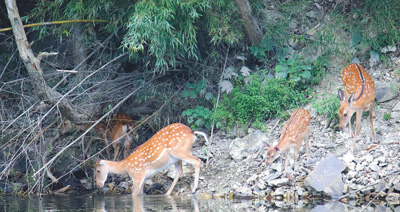




- BRNN
- BRI News
- BRNN News
- Database
Official Documents Polices and Regulations
Inter-government Documents International Cooperation BRI Countries
Business Guide Economic Data BRI Data
Trade
Investment Projects Latest projects
Cases - Content Pool
Taohongling Sika Deer National Nature Reserve in Pengze county, east China's Jiangxi Province, has seen a dramatic increase in its sika deer population, thanks to conservation efforts by the reserve and local residents.
Staff at the Shangshiling protection station are responsible for monitoring the sika deer, a south China subspecies under first-class national protection. The reserve's administration bureau and local villagers have helped the population grow to over 670.

Photo shows wild sika deer in Taohongling Sika Deer National Nature Reserve in Pengze county, east China's Jiangxi Province. (Photo courtesy of Taohongling Sika Deer National Nature Reserve)
The conservation effort began in 1980 when wild sika deer were discovered in Taohongling. A provincial-level nature reserve was established the following year and upgraded to national status in 2001.
"I've been working at the reserve's administration bureau for 36 years now," said Liu Xiaohong, the 56-year-old director of the reserve's ecological monitoring station.
"Our monitoring station was once high in the mountains, lacking electricity, water and road access," Liu recalled. "Living there meant mosquito bites in summer and freezing winds in winter." He added that each patrol required a hike of more than 10 kilometers through mountain trails, a round trip of four to five hours.
"Public awareness of ecological conservation has increased significantly, and illegal hunting has virtually disappeared," Liu said. Now, his focus is primarily on ecological monitoring.
"Besides observing the surrounding environment and handling forest fire prevention, we take photos of any wildlife we spot during patrols," Liu noted, adding that sika deer are often spotted foraging and resting among the trees.
"Additionally, we've built an intelligent monitoring platform for real-time, comprehensive monitoring and analysis," said Dai Jie, deputy director of the reserve's administration bureau. The reserve has strategically placed over 280 infrared cameras and 39 real-time monitoring cameras, providing crucial data support for protecting sika deer and other rare wildlife.
The sika deer population has increased from fewer than 60 to more than 670 after more than 40 years of conservation efforts, according to a November 2024 survey.
Liu said the reserve has created more than 10 wildlife corridors along mountain ridges for sika deer and other animals.
To supplement micronutrients like sodium, iron and zinc, the reserve has constructed 29 salt lick sites in areas where sika deer are commonly found. Additionally, six water sites have been established to ensure the deer and other wildlife have drinking water during dry periods.
The reserve started habitat restoration projects in 2002 to provide more space for sika deer, said Ying Xia, another deputy director of the reserve's administration bureau.
Ying added that the reserve works with research institutions to study and monitor the area's rare wildlife, including sika deer. They conduct surveys, analyze ecosystem changes and perform ongoing research on the animals.

Photo shows a scene of Taohongling Sika Deer National Nature Reserve in Pengze county, east China's Jiangxi Province. (Photo courtesy of the convergence media center of Pengze county)
Since 2022, the reserve has provided insurance for crop damage caused by wildlife annually, with 143 villagers receiving compensation last year, Dai said.
"Meanwhile, we've stepped up public education about sika deer protection through social media accounts that combine scientific information with publicity," Dai added. "We've also built a sika deer learning center to teach people about them."
Over the years, more people have joined the sika deer protection team. "With local government support, we've established a joint protection committee that integrates multiple departments, towns and townships, clearly assigning specific responsibilities," Ying said.

Tel:86-10-65363107, 86-10-65368220, 86-10-65363106